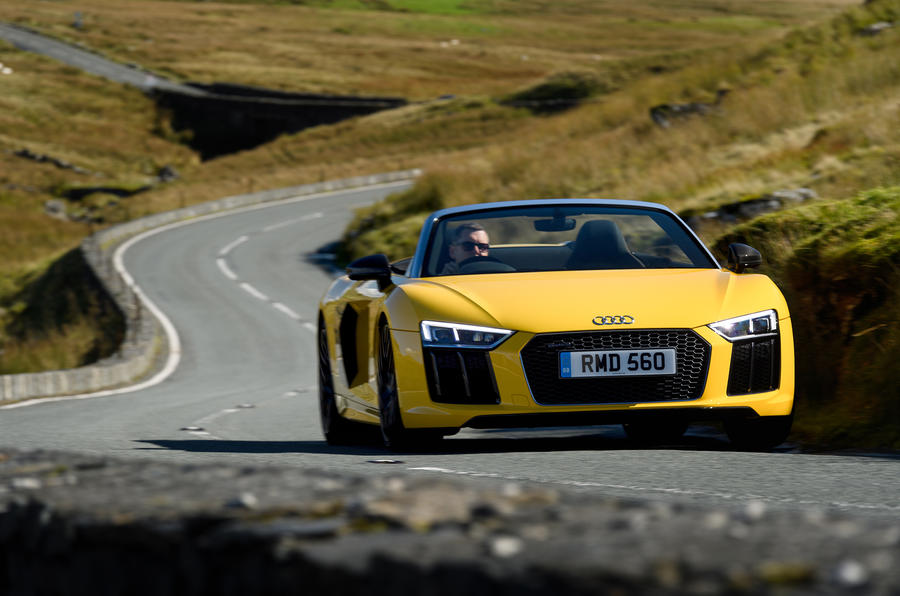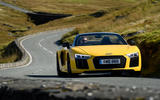What is it?
Darn fine car, the Audi R8 Coupé. Really, it’s among the best supercars you can buy, rubbing shoulders with the pantheon of greats from Maranello, Sant’Agata, Stuttgart and Woking. However, these supercars are rarely so super when you lop the roof off and turn them into cabriolets. Has this act of apparent brutality sullied the mighty R8?
In an attempt to maintain the structural rigidity of the Coupé the composite central tunnel and rear bulkhead have been retained, but the latter is modified to accommodate the folding roof. The aluminium spaceframe that extends forward from it also has thicker box sections in the sills and around the windscreen. This makes it 50% stiffer than the old R8 Spyder, but it still has 40% more flex than the current Coupé.
To keep it as light as possible – the complete soft-top mechanism alone weighs 44kg – there’s a carbonfibre engine cover. Under it you’ll find one of the very best engines available today: the delicious naturally aspirated 5.2-litre V10. Its 533bhp matches the Coupé’s at the same 7800rpm, and adds 15bhp to the old car’s tally. Cylinder-on-demand tech lets it run on five cylinders by swapping between alternate banks of the vee, and along with both direct and indirect injection and an ability to freewheel when off the throttle, it’s as efficient as possible.
Our test is carried out in England, complete with its rigidity testing bumps, cambers and curves.
What's it like?
The Audi R8 Spyder will get you from rest to 62mph in 3.6sec. That's half a second down on a Porsche 911 Turbo Cabriolet, which has the same power but which weighs less. But it’s the zero to 124mph time, picked off in 11.8sec, that really addles the brain - both to think about and experience - and it won’t stop accelerating until the speedo reads 197mph.
So it’s supremely fast, even before talk of the 602bhp Plus version that's likely to arrive next year. More pertinently, though, the R8’s power is delivered the old-school way: no artificial boost means an absolutely predictable throttle response. Plant your foot and the torque doesn’t wallop you like a turbo-charged Frisbee to the temple after a brief pause, as it does in most rivals. No, the V10 responds immediately but progressively, building and building, before finally flowing in to warp somewhere around 6500rpm. The point here is you are never surprised by it; a good thing when there’s 398lb ft of the stuff on tap.
Along with the well-judged four-wheel drive, the Spyder makes for a supremely tractable car, but one that’s no less playful or dramatic as a result. And, speaking of drama, we haven’t mentioned the noise yet. No other supercar (bar the Lamborghini Huracán that shares its engine) sounds this good.
Did you know that the distinctive sound of a V10 is the result of two separate sound waves – one low and the other an octave-and-a-third higher? Well, there’s no better way to hear this than in an open-top R8 through a tunnel. It’s delicious, intoxicating and grin-inducing; and that’s before you’ve factored in the whip-snapping fire cracks on the overrun.
Yes, the Spyder is heavier than the Coupé, at 1795kg at the kerb (25kg down on the last generation Spyder). And, yes, you feel that 40% reduction in stiffness – although in just a slight shimmy through the steering column here, and an occasional wobble of the rear-view mirror there. But avoid the adaptive steering and in essence this is still a car with a phenomenal front end that weights up beautifully as you carve between apexes. The four-wheel drive lets you play with the rear end when you fancy, but digs in and grips when the weather turns nasty. Essentially it’s a friendly partner to the experience, rather than a frustrating intrusion.









































Add your comment